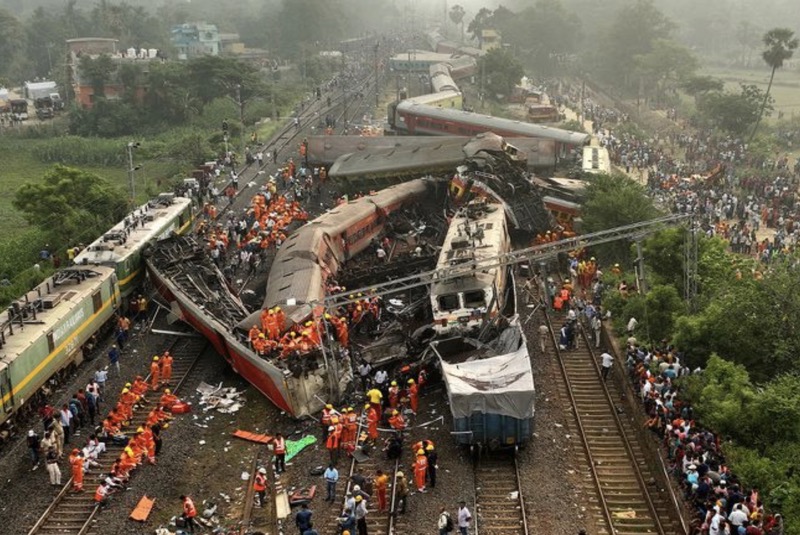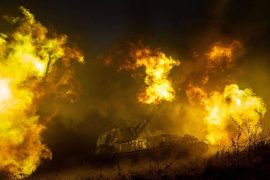A deadly train crash in India killed more than 288 people and injured more than 700 people. The ‘three-way accident’ involving two passenger trains and an idle freight train is one of the worst train crashes in over two decades.
According to an initial government report, the Coromandel Express, a high-speed train from Kolkata, was ‘going at full speed across the station as it was not supposed to stop’ at Bahanaga Bazar, a small-town station in Odisha. However, at around 7 PM, the train carrying 1257 passengers collided with an idle freight train, derailing and bouncing twenty-one coaches off the track. Three of those coaches sprawled onto another track.
Simultaneously, the Yeshwantpur Howrah Express, a passenger train from Bangalore to Kolkata with 1039 passengers, was headed in the opposite direction – on the track where the three dislocated coaches lay. The second collision derailed the last two coaches of the third train.
Officials did not have any explanation of why the freight train was stopped. They did not even explain why the Coromandel Express was not alerted to its presence on the tracks. The Chief Public Relations Officer of Southern Eastern Railways, Aditya Kumar Chaudhary, confirmed that a ‘preliminary inquiry’ indicated that the crash was due to a signal failure, adding that those initial suggestions needed to be thoroughly investigated. ‘The train was to go for the main line, but a signal pointer was given for the loop line. That is what the supervisors have pointed out,’ said Aditya Kumar Chaudhary, adding ‘lots of many ifs and buts are there. It has to be checked and cross-checked.’
Speaking to the Press, the Railways minister, Ashiwini Vaishnaw, sounded more evasive. He said he ordered an investigation to determine the cause of the crash and emphasised that ‘the immediate focus is on rescue and relief.’ Critics quickly pointed out that the Railway minister did not take moral responsibility for letting such a disaster happen on his watch. Brahman Chellany, an analyst, tweeted:
There was a time in India when the railway minister would resign after a major train accident. Now that the country’s worst rail disaster in two decades involving three trains has exposed major rail-safety problems, would the present railway minister set an example by resigning?
India’s railway system, developed by the British, is one of the largest in the world, transporting more than 8 billion passengers a year. The train crash raises questions about the safety of India’s railway system.
In 2012, a committee appointed to review the safety of India’s rail network highlighted ‘inadequate performance largely due to poor infrastructure and resources.’ It recommended a series of measures such as upgrading tracks, repairing bridges, eliminating road-level crossings and replacing old train cars with better ones to protect passengers in an accident.
In 2016, a deadly train crash caused by a ‘fracture’ in the train tracks killed more than 140 people and injured more than 200 people when 14 train cars derailed in the Northeast of India. In 2017, another train crash killed at least 36 passengers and injured forty others.
Before the Odisha train accident, the Railways got two warnings in 6 months on faulty signalling and poor track repair. In December 2022, a report by the Comptroller and Auditor General of India, titled ‘Derailments in Indian Railways,’ which looked into reasons behind train derailments between April 2017 to March 2021, found that inadequate maintenance of tracks was one of the major contributors to such accidents. Further, it cited 24 reasons for derailment.
In February, after a collision was avoided, The Print reported that the principal chief operating manager of the South Western Railway zone had written to the authorities about ‘serious flaws’ in the signalling system. In a stinging letter, the official warned that if glitches in the signalling system are not fixed, they could lead to ‘re-occurrence and serious accidents.’
Prime Minister Narendra Modi, who visited the site of the collision, said that his administration would take tough measures to punish the guilty after a thorough investigation. However, he did not mention why the railway safety systems were not upgraded and implemented.
The Modi government, which harps on launching trains as election propaganda, has much to explain about this tragedy which could have been avoided with better supervision and maintenance. The Ministry of Railways has much to explain signal and track maintenance safety lapses.
Though India’s Railway network claims to be the largest in the world, its trains are also among the most unsafe and dangerous in the world. If railways are more than election propaganda, the government has much to do to rectify the situation so that such avoidable accidents do not occur in the future.
-30-
Copyright©Madras Courier, All Rights Reserved. You may share using our article tools. Please don't cut articles from madrascourier.com and redistribute by email, post to the web, mobile phone or social media.Please send in your feed back and comments to editor@madrascourier.com











